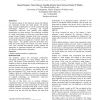Free Online Productivity Tools
i2Speak
i2Symbol
i2OCR
iTex2Img
iWeb2Print
iWeb2Shot
i2Type
iPdf2Split
iPdf2Merge
i2Bopomofo
i2Arabic
i2Style
i2Image
i2PDF
iLatex2Rtf
Sci2ools
CHI
2002
ACM
2002
ACM
The effect of tangible interfaces on children's collaborative behaviour
The physical nature of the classroom means that children are continually divided into small groups. The present study examined collaboration on a story creation task using technologies believed to encourage and support collaborative behaviour. Four children used tangible technologies over three sessions. The technology consisted of a large visual display in which they could input content (using Personal Digital Assistants (Pda) and a scanner), record sounds (using RF-ID tags) and navigate around the environment using an arrangement of sensors called `the magic carpet'. The children could then retell their story using bar-coded images and sounds. The three sessions were video recorded and analysed. Results indicate the importance of immediate feedback and visibility of action for effective collaboration to take place. Keywords Children, tangible interfaces, collaboration
CHI 2002 | Human Computer Interaction | Story Creation Task | Study Examined Collaboration | Tangible Technologies |
| Added | 01 Dec 2009 |
| Updated | 01 Dec 2009 |
| Type | Conference |
| Year | 2002 |
| Where | CHI |
| Authors | Danae Stanton, Victor Bayon, Camilla Abnett, Sue Cobb, Claire O'Malley |
Comments (0)

